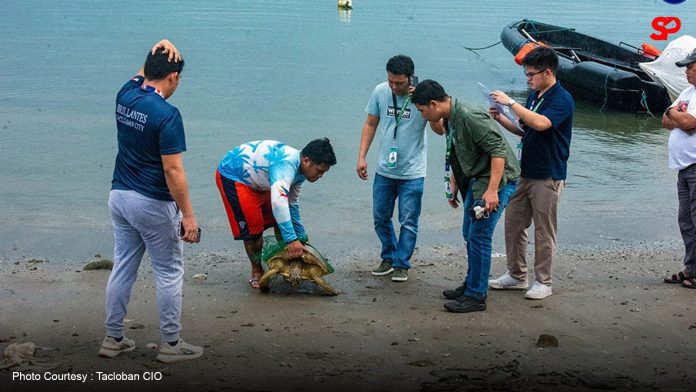By Xander Ledesma
A green sea turtle, estimated to be between 5 and 8 years old, was found dead in Tacloban City after a valiant but ultimately unsuccessful rescue effort. The turtle was discovered by Domingo Tonod floating inside his fish cage in Sitio Kaliro, Diit, at around 4 a.m. on Thursday, January 16, 2025.
Recognizing the importance of his discovery, Tonod immediately contacted the Fishery Law Enforcement Team (FLET) for assistance. Upon arrival, personnel from the Department of Environment and Natural Resources (DENR) assessed the turtle, measuring it for monitoring and data collection purposes. Unfortunately, despite initial efforts to rescue and care for the animal, the turtle passed away the following day, Friday, January 17.
Green sea turtles, or *Chelonia mydas*, are classified as endangered by the International Union for Conservation of Nature (IUCN). Their presence in the waters around Tacloban serves as a reminder of the region’s rich but increasingly threatened marine biodiversity. The discovery of this particular turtle has raised concerns about the rising threats to these creatures, particularly the impact of marine pollution.
According to the DENR, the suspected cause of death was the ingestion of plastic debris. Marine life, including sea turtles, is often attracted to plastic waste floating in the ocean, mistaking it for food. Ingesting plastic can be harmful or even fatal, making it a growing environmental issue worldwide.
This incident underscores the ongoing environmental challenges facing the Philippines, an archipelagic country rich in marine biodiversity. Tacloban, located in the Eastern Visayas region, is home to a variety of endangered species, including sea turtles, which play a critical role in marine ecosystems. Green sea turtles, in particular, are essential for maintaining the health of seagrass beds and coral reefs, vital to the overall balance of marine life.
While the presence of sea turtles in the region reflects its ecological value, it also highlights the vulnerabilities that marine life faces due to pollution, illegal fishing, and habitat destruction. The Philippines has made significant strides in marine conservation, including the creation of marine protected areas and the implementation of fishing regulations. However, challenges remain as plastic pollution continues to plague the oceans.
Green sea turtles are known for their long migrations, sometimes traveling thousands of miles across the ocean. Their ability to navigate vast waters makes them particularly vulnerable to the dangers of ocean pollution, emphasizing the critical need for their conservation. Although the Philippines has made substantial investments in protecting marine species, inadequate waste management practices continue to threaten marine life.
The tragic death of the green sea turtle serves as a stark reminder of the importance of proper waste disposal and environmental responsibility. The DENR is urging the public to be more mindful of their waste disposal habits, especially in coastal areas, to prevent further harm to marine animals.
Plastic pollution is a global issue, and the Philippines is no exception. Every year, millions of tons of plastic waste enter the oceans, where it can persist for hundreds of years. Efforts to reduce plastic waste have gained momentum in the country, with cities like Tacloban implementing ordinances and educational campaigns aimed at reducing plastic consumption. However, the battle against marine pollution is far from over.
The death of the green sea turtle is a wake-up call for urgent collective action to preserve the environment. Beyond stricter enforcement of waste management laws, it is essential for communities to actively participate in environmental preservation efforts.
In Tacloban and throughout the Philippines, environmental groups, local government units, and citizens must collaborate to safeguard the country’s precious marine life. From reducing plastic use to increasing awareness of the threats posed by ocean pollution, every effort counts.

